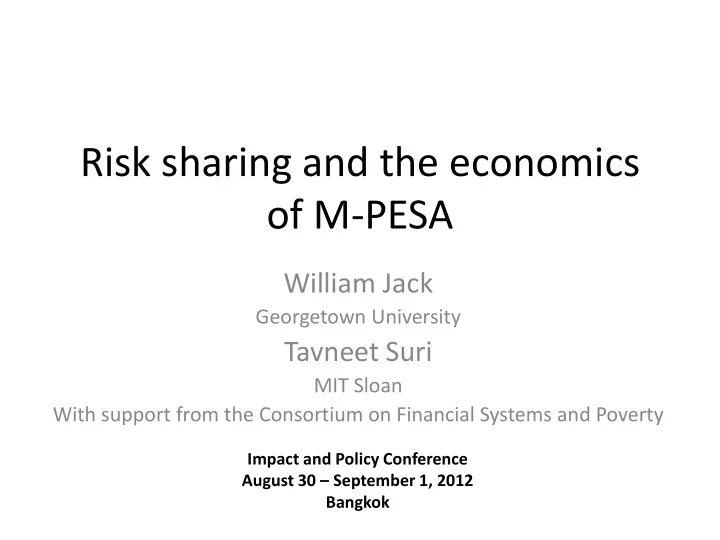

Risk sharing and the economics of M-PESA William Jack Georgetown University Tavneet Suri MIT Sloan With support from the Consortium on Financial Systems and Poverty Impact and Policy Conference August 30 – September 1, 2012 Bangkok
The problem: The solution: Jack - M-PESA
M-PESA as a risk spreading tool • Formal insurance is limited • Informal insurance exists, but is often incomplete…….why? • Moral hazard: information asymmetries • Limited commitment: contract enforcement • Transaction costs Jack - M-PESA
Summary of findings • The consumption of households who don ’ t use M-PESA falls by about 7% - 10% when they suffer negative shocks • Lower transaction costs allow households who use M-PESA to smooth these risks perfectly
The M-PESA concept • Remote account storage accessed by simple SMS technology • Cash-in and cash-out services provided by M- PESA agents Jack - M-PESA
? Customer and Agent growth 16 30,000 Millions 14 25,000 12 2011 20,000 10 2009 Customers 2010 Agents 8 15,000 Customers 6 10,000 2008 Agents 4 5,000 2007 2 0 0 Oct-06 Apr-07 Nov-07 Jun-08 Dec-08 Jul-09 Jan-10 Aug-10 Feb-11 Sep-11 Jack - M-PESA
Lake Victoria Nairobi Mombasa June 2007 Note: partial data only Jack - M-PESA
Lake Victoria Nairobi Mombasa Dec 2007 Note: partial data only Jack - M-PESA
Lake Victoria Nairobi Mombasa June 2008 Note: partial data only Jack - M-PESA
Lake Victoria Nairobi Mombasa Dec 2008 Note: partial data only Jack - M-PESA
Lake Victoria Nairobi Mombasa June 2009 Note: partial data only Jack - M-PESA
Lake Victoria Nairobi Mombasa Dec 2009 Note: partial data only Jack - M-PESA
Lake Victoria Nairobi Mombasa June 2010 Note: partial data only Jack - M-PESA
Our household survey • 3,000 households across most of Kenya • Four rounds: 2008, 2009, 2010, 2011 Somalia Uganda Nairobi Tanzania Indian Ocean Jack - M-PESA
Who is using M-PESA? 100% 75% 50% Households outside Nairobi 25% Median consumption ~$2 per day 0% 2008 2009 2010 2011 >$2/day $1.25-$2/day <$1.25/day Jack - M-PESA
Banking for the unbanked? 100% 75% 50% Households outside Nairobi 25% Median consumption ~$2 per day 0% 2008 2009 2010 2011 Unbanked Banked Jack - M-PESA
How do people use M-PESA? 100% Share of households 80% 60% 40% 20% Transactions 0% 2009 data Jack - M-PESA
How often do people use M-PESA? Less often 24% Once a year 4% Every 6 months 4% Every 3 months 14% Monthly 43% Every 2 weeks 6% Weekly 5% Daily 2% 0% 10% 20% 30% 40% 50%
Transaction Costs 1,400 1,200 1,000 800 Tariff 600 400 200 0 0 5,000 10,000 15,000 20,000 25,000 30,000 35,000 40,000 Amount deposited and sent Postapay M-PESA: Reg to reg Western Union
Empirical strategy c = a + Shock + User + b User * Shock + controls Consumption User Shocks don’t hurt Users are richer ( ) users so much ( b ) Non-user ( a ) Shocks hurt ( ) No shock Shock Shock status
Basic Results OLS A Panel B Panel C Without Nairobi C M-PESA User 0.553*** -0.090** -0.016 -0.008 [0.037] [0.036] [0.047] [0.049] Negative Shock -0.207*** 0.241** 0.232 0.120 [0.038] [0.116] [0.169] [0.141] User*Negative Shock 0.101** 0.176*** 0.156** 0.150** [0.050] [0.050] [0.062] [0.065] Shock, Users -0.105*** 0.052* 0.055 0.050 [0.033] [0.028] [0.035] [0.037] Shock, Non-Users -0.207*** -0.069** -0.068 -0.056 [0.038] [0.032] [0.043] [0.045] A: Full sample with time Fes; B: Full sample with controls + interactions C: Full sample, controls + interactions, time and time x location FEs Jack - M-PESA
Improving Agent Access 4 Distance to the 3.5 closest agent 3 (km) 2.5 22% Change 2 Round 1 33% 14% Round 2 Change Change 1.5 28% 40% Change 1 Change 0.5 0 Mean Distance 5th Percentile 25th Percentile 50th Percentile 75th Percentile (km) Jack - M-PESA
Using Agent Roll Out Agents w/in Agents Agents w/in Agents Distance to 1km w/in 2km 5km w/in 20km Agent Negative Shock 0.152 0.122 0.148 -0.176 0.619*** [0.152] [0.153] [0.160] [0.140] [0.203] Agents -0.022 -0.003 0.018 -0.002 0.051 [0.039] [0.031] [0.024] [0.006] [0.054] Agents*Shock 0.055*** 0.050*** 0.021** -0.002 -0.058*** [0.019] [0.015] [0.010] [0.005] [0.019] Jack - M-PESA
Mechanisms • Consumption smoothing could be effected through – Remittances – Savings – Information/communication • We find remittances are the dominant factor – More likely, More often, More – Larger network Jack - M-PESA
Recommend
More recommend